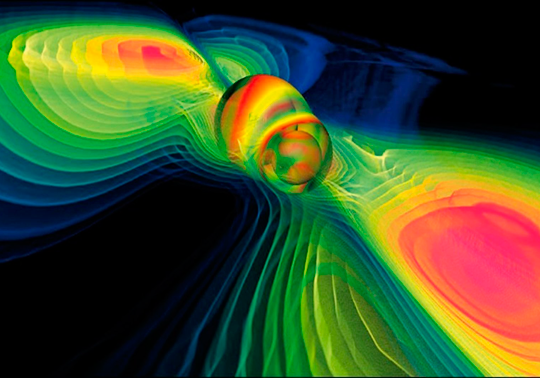Third detection of gravitational waves from a binary black hole merger
- June 1st, 2017

The Laser Interferometer Gravitational-Wave Observatory (LIGO) has made the third detection of gravitational waves, ripples in the space-time. As it happened with the first two detections, the waves were formed after the fusion of two black holes to create a bigger black hole. The new black hole, located at 3 billion light-years of distance (twice as far as the two previously discovered systems), has a 49 times the mass of the Sun. It is an intermediate value between the mass of the ones which were detected in 2015 (62 ad 21 solar masses for the first and second detections).
The discovery is described in a new article accepted for publication in the journal Physical Review Letters. The event occurred during the current observing run of the twin LIGO detectors in Hanford, Washington, and Livingston, Louisiana, which began November 30, 2016, and will continue through the summer, when the Virgo detector in Europe will join to improve the pointing capability of the entire detector network.
"With this third detection we confirm the existence of an unexpected population of stellar-mass black holes that are larger than 20 solar masses," says Jo van den Brand of Nikhef and VU University Amsterdam, the newly elected spokesperson for the Virgo Collaboration, a body of more than 280 international scientists who perform gravitational waves research together with the LIGO Collaboration. "The entire LIGO and Virgo scientific collaborations worked together to make these amazing detections of such extreme events that took place billions of years ago.”
The third detection, called GW170104 and made on January 4th, 2017, was carefully analysed by the LIGO Scientific Collaboration (LSC) and the European-based Virgo collaboration. This is a group of more than 1200 researchers from more than 100 scientific institutions, spread over four different continents. Previously, this worldwide effort successfully led to the first-ever direct observation of gravitational waves in September 2015 during the first observing run of the LIGO detectors. Then, a second detection was made in December 2015. In all three cases, the detected gravitational waves were generated by extremely energetic collisions of black hole pairs – events that produce more power during the instant before the black holes merge, than is radiated as light by all the stars and galaxies in the observable Universe at any given time.
The newest observation also provides clues about the directions in which the black holes are spinning. As pairs of black holes spiral around each other, they also spin on their own axes. This is similar to a pair of ice skaters spinning individually while also circling around each other. Black holes can spin in any direction. Sometimes black holes spin in the same overall orbital direction as the pair is moving – what astronomers refer to as aligned spins – and sometimes they spin in the opposite direction. What’s more, black holes can also be tilted away from the orbital plane. The data analysis provides evidence that at least one of the black holes may have been non-aligned to the overall orbital motion, offering hints about how the pair formed.
Virgo has undergone a major upgrade programme called Advanced Virgo. A first engineering run with all systems operational was completed successfully in the first week of May. The sensitivity is improving rapidly and Virgo is expected to soon join the LIGO detectors in our quest to obtain a deeper understanding of the origin and evolution of our Universe.
LIGO is funded by the NSF, and operated by Caltech and MIT, which conceived and built the project. More than 1,000 scientists from around the world participate in the effort through the LIGO Scientific Collaboration, which includes the GEO Collaboration. Additional partners are listed at: http://ligo.org/partners.php.
VIRGO research is carried out by the Virgo Collaboration, consisting of more than 280 physicists and engineers belonging to 20 different European research groups: 6 from Centre National de la Recherche Scientifique (CNRS) in France; 8 from the Istituto Nazionale di Fisica Nucleare (INFN) in Italy; 2 in The Netherlands with Nikhef; the MTA Wigner RCP in Hungary; the POLGRAW group in Poland; and the European Gravitational Observatory (EGO), the laboratory hosting the Virgo detector near Pisa in Italy. Recently, also Spain joined the Virgo collaboration, with a new group in Valencia.
The group of the Universitat de València is the only Spanish group of the Virgo collaboration since July 2016. It is formed of researchers of the Department of Astronomy and Astrophysics and the Department of Mathematics of that university. Since 2002, Spain is also represented in the LIGO Scientific Collaboration by the Relativity and Gravitation Group of the University of the Balearic Islands. This group has taken part in the three detections of the gravitational waves.
The group of the Virgo collaboration of the Universitat de València is supported by the Ministry of Economy and Competitiveness (AYA2015-66899-C2-1-P), the Valencian Government (PROMETEOII-2014-069), the Spanish Supercomputing Network and the Partnership for Advanced Computing in Europe (PRACE). It also takes part in the Theme Network for Gravitational Waves ‘REDONGRA’, funded by the Ministry of Economy and Competitiveness (FPA2015-69815-REDT).
For more information:
Webpage of the Virgo collaboration group of the Universitat de València: http://www.uv.es/virgogroup/
File in: Astronomía i Astrofísica , Matemàtiques , Grups de recerca , Projectes Europeus
















